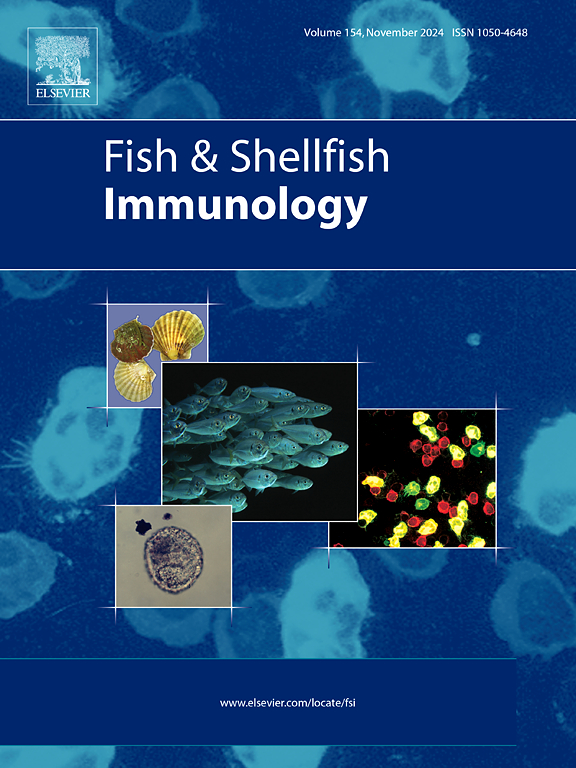miR-146a is critical for orchestrating Mycobacterium fortuitum survival through anti-inflammatory and M2 macrophage responses in fish
IF 4.1
2区 农林科学
Q1 FISHERIES
引用次数: 0
Abstract
The significance of microRNAs (miRNAs) in host response to non-tuberculoid mycobacteria like Mycobacterium fortuitum remains nascent. Using zebrafish kidney macrophages (ZFKM), we elucidate a novel function of miR-146a, orchestrated by the TLR-2-PI3K-NF-κB pathway, in M. fortuitum pathogenesis. We demonstrate that miR-146a facilitates anti-inflammatory response by targeting IRAK-1 and TRAF-6 in M. fortuitum-infected ZFKM. Moreover, miR-146a mitigates M1 macrophage activity by suppressing the iNOS-NO axis while enhancing M2-specific TGF-β mRNA expression and subsequent inhibition of M. fortuitum eradication. These findings collectively suggest that miR-146a diminishes macrophage-mediate M. fortuitum clearance. Our study provides novel insights into the intricate interplay between miRNAs and mycobacterial infections. We propose a mechanistic model wherein the TLR-2/NF-κB axis initiates miR-146a expression, which, in turn, suppresses irak-1 and traf-6, fostering the development of M2 macrophages. Consequently, this creates an anti-inflammatory environment conducive to M. fortuitumsurvival. Our findings provide novel insights into the intricate interplay between miRNAs and mycobacterial persistence, a concerning aspect of pathogenesis.
miR-146a通过抗炎和M2巨噬细胞反应在鱼类中调控偶发分枝杆菌的存活至关重要。
microRNAs (miRNAs)在宿主对非结核分枝杆菌(如福氏分枝杆菌)的应答中的意义尚不明确。利用斑马鱼肾巨噬细胞(ZFKM),我们阐明了miR-146a通过TLR-2-PI3K-NF-κB通路介导的一种新功能。我们证明miR-146a通过靶向IRAK-1和TRAF-6,促进了福氏分枝杆菌感染ZFKM的抗炎反应。此外,miR-146a通过抑制iNOS-NO轴,同时增强m2特异性TGF-β mRNA表达和随后抑制fortuum根除来减轻M1巨噬细胞活性。这些发现共同表明,miR-146a减少巨噬细胞介导的偶然性支原体清除。我们的研究为mirna和分枝杆菌感染之间复杂的相互作用提供了新的见解。我们提出了一个机制模型,其中TLR-2/NF-κB轴启动miR-146a表达,miR-146a反过来抑制伊拉克-1和交通-6,促进M2巨噬细胞的发育。因此,这创造了一个有利于幸运分枝杆菌存活的抗炎环境。我们的发现为mirna和分枝杆菌持久性之间复杂的相互作用提供了新的见解,这是发病机制的一个重要方面。
本文章由计算机程序翻译,如有差异,请以英文原文为准。
求助全文
约1分钟内获得全文
求助全文
来源期刊

Fish & shellfish immunology
农林科学-海洋与淡水生物学
CiteScore
7.50
自引率
19.10%
发文量
750
审稿时长
68 days
期刊介绍:
Fish and Shellfish Immunology rapidly publishes high-quality, peer-refereed contributions in the expanding fields of fish and shellfish immunology. It presents studies on the basic mechanisms of both the specific and non-specific defense systems, the cells, tissues, and humoral factors involved, their dependence on environmental and intrinsic factors, response to pathogens, response to vaccination, and applied studies on the development of specific vaccines for use in the aquaculture industry.
 求助内容:
求助内容: 应助结果提醒方式:
应助结果提醒方式:


